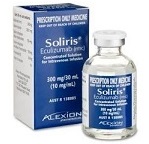The U.K.'s cost-effectiveness gatekeepers think Alexion's ($ALXN) newest rare-disease drug, Kanuma, may be worth using in babies with lysosomal acid lipase deficiency. But it's going to need to see more research on the pricey med's costs and benefits before it shells out.
At £491,992 ($704,630), the therapy doesn't represent good value for all patients, the National Institute of Heath and Care Excellence (NICE) said in draft guidance. But there's still time for the company to change the watchdog's mind before it makes a final decision.
Alexion, for its part, said in a statement that NICE had "failed to recognize the transformative clinical innovation of Kanuma" as a treatment for LAL deficiency, which can be particularly serious in babies. The inherited genetic disease causes fat to build up in cells, with survival for babies pegged at less than 12 months.
Now, though, it'll be up to the Connecticut drugmaker to prove the treatment's worth--and it has plenty of experience in that department. In December 2014, NICE agreed to back Alexion's Soliris--considered the most expensive drug in the world--for patients with atypical hemolytic uremic syndrome, despite failing to receive information it had requested on the company's R&D costs.
 Of course, a few strings were attached to that recommendation. NICE required a national protocol for starting and stopping Soliris for clinical reasons, a research program that evaluates when to stop treatment or adjust dosage, monitoring systems to record the number of aHUS patients, and coordination of Soliris through an expert center.
Of course, a few strings were attached to that recommendation. NICE required a national protocol for starting and stopping Soliris for clinical reasons, a research program that evaluates when to stop treatment or adjust dosage, monitoring systems to record the number of aHUS patients, and coordination of Soliris through an expert center.
And since then, the Cheshire-based company hasn't been quite so successful when it comes to winning NICE's stamp of approval. This past December, the institute said it couldn't justify the cost for Strensiq--which fights the very rare and crippling condition pediatric-onset hypophosphatasia--at more than half a million dollars per year.
- read the draft guidance (PDF)
Special Report: Top 20 orphan drugs by 2018 - Soliris